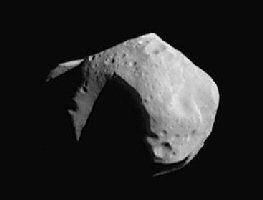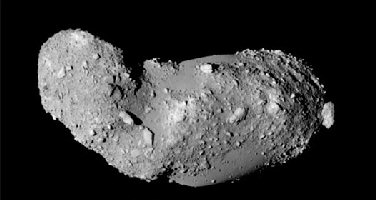- ASTEROIDS
A
Asteroids are small, airless rocky worlds revolving around the sun that are too small to be called planets. They are also known as planetoids or minor planets. In total, the mass of all the asteroids is less than that of Earth's moon. But despite their size, asteroids can be dangerous. Many have hit Earth in the past, and more will crash into our planet in the future. That's one reason scientists study asteroids and are eager to learn more about their numbers, orbits and physical characteristics. If an asteroid is headed our way, we want to know that.Most asteroids lie in a vast ring between the orbits of Mars and Jupiter. This main belt holds more than 200 asteroids larger than 60 miles (100 kilometers) in diameter. Scientists estimate the asteroid belt also contains more than 750,000 asteroids larger than three-fifths of a mile (1 kilometer) in diameter and millions of smaller ones. Not everything in the main belt is an asteroid — for instance, comets have recently been discovered there, and Ceres, once thought of only as an asteroid, is now also considered a dwarf planet.Asteroid belt

The asteroid belt occupies the orbit between Mars and Jupiter, between 2.3 and 3.3 AU from the Sun. It is thought to be remnants from the Solar System's formation that failed to coalesce because of the gravitational interference of Jupiter.Asteroids are small Solar System bodies composed mainly of refractoryrocky and metallic minerals, with some ice.
Asteroids range in size from hundreds of kilometres across to microscopic. All asteroids except the largest, Ceres, are classified as small Solar System bodies.
The asteroid belt contains tens of thousands, possibly millions, of objects over one kilometre in diameter.Despite this, the total mass of the asteroid belt is unlikely to be more than a thousandth of that of the Earth.The asteroid belt is very sparsely populated; spacecraft routinely pass through without incident. Asteroids with diameters between 10 and 10−4 m are calledmeteoroids.
IMPACTS
Asteroids are quite different from comets. Even without looking at them in great detail there are some obvious differences. One thing about asteroids is that they weren't discovered until the invention of the telescope. The first asteroid to be discovered wasn't found until 1801 and was named Ceres. This is also the largest of the asteroids, about 940 km wide. The discovery of more and more asteroids over the years has us believing that there are likely billions of asteroids out there but only a couple hundred larger than 100 km. The vast majority are so small you could easily hold one in your hand. The number of known asteroids changes every month with new discoveries, and there are currently more than 100,000 known asteroids. Unlike comets, asteroids are found relatively close to the ecliptic plane and their orbits are not as stretched out as comets' but are more circular. This is why asteroids are also called Minor Planets. The vast majority of asteroids are found in the asteroid belt between the orbits of Mars and Jupiter. This gives them a typical distance from the Sun of about 2-3.5 A.U. To see the latest plot of asteroids, just follow this link - more than 100,000 objects are plotted.
You may also notice that there are some asteroids located along the orbit of Jupiter, both in front of and behind Jupiter. These are the Trojan asteroids. They are in those locations because of Jupiter's strong pull on them. They orbit the Sun with the same orbital period as Jupiter, so they are always located in the same positions relative to Jupiter, either always before or always after Jupiter. Jupiter has the most trojan asteroids, but Mars, and Neptune also have them, but only a few. In 2011, the first trojan asteroid of the Earth was announced (it has the lovely name 2010 TK7). It is trapped in a location that causes it to always remain in front of the Earth as both travel around the Sun.
There are also asteroids that are found closer to the Sun, and included in this group are the N.E.A. - Near Earth Asteroids. These are the ones we want to pay close attention to since they can cross the Earth's orbit - sometimes they get quite close. Some of these have already been labeled as PHA- Potentially Hazardous Asteroids.
 |  | ||
Studies of asteroids have been spotty at best. As you'll see, one of the best ways to study them is after they fall to the Earth and are picked up as meteorites, but I'll get to that later. Only on a few occasions have we observed asteroids in their native environment. The Galileo spacecraft obtained images of two asteroids, Gaspra and Ida, on its journey to Jupiter. At rare times, N.E.A.s get close enough to Earth for astronomers to map them out with radar, which provides information on their shapes and surfaces. On February 14, 2000 the NEAR spacecraft went into orbit about the asteroid Eros. It thoroughly mapped and scanned the surface of Eros from that time until February 2001. At the end of the mission, the NASA folks thought it would be cool to see if they could land the spacecraft on the surface of the asteroid - and they did! The darn thing landed fairly safely on the surface, even though it wasn't designed to land. By the way, NEAR stands for Near Earth Asteroid Rendezvous - another one of those cute astronomy abbreviations.
The japanese spacecraft, Hayabusa was able to land on, and take off from an asteroid named Itokawa with a sample of material from the surface. The Dawn spacecraft is currently (Summer 2011) in the asteroid belt in orbit about the large asteroid Vesta. There are likely going to be more details about asteroids known in the future as results from these missions are made available.
After data of the orbits of many asteroids were collected, some rather interesting aspects were seen in their distributions in the asteroid belt. There are a bunch of locations where few asteroids are found. These gaps were first noted by a fellow named Kirkwood, so they are called theKirkwood gaps. Why are they there? The gaps are seen at places in the asteroid belt where asteroids have orbital periods that are a fraction of Jupiter's, like 1/2, 1/3, 1/4 and so on. When an asteroid has an orbital period that is one of these fractions of Jupiter's, that means that the asteroid and Jupiter will be lined up on a regular basis and Jupiter will be able to pull the asteroid a bit more than normal. Jupiter tends to pull such asteroids out of these resonant orbits and produce the gaps.
Astronomers have only recently been able to get up close views of asteroids, but even without that data we have an idea about what they are made of (or at least what their surfaces are made of) based upon how light reflects off of them and by looking at their spectra. It appears that the compositions of asteroids vary with their distances from the Sun. Those near the orbit of Mars are S-Types (silicate rich, rocky objects), while those further out (about 2.7 A. U. and beyond) are designated as C-Types (carbon rich). There are also some M-Types (metallic composition) mixed in with the S-types. The general breakdown of the various types is that about 75% are C-types, 15% are S-Types, and most of the remaining 10% are M-types. It is possible that the really distant asteroids have quite a bit of ice in them.
You'll notice how the asteroid compositions also vary with distance from the Sun and work in quite well with the density variations of the planets - cool, eh? As mentioned, asteroids are very small in size. When an object is very small, it tends to not be circular in shape. Why is that? High gravity tends to make things circular so that all parts have an equal pull inwards. If you don't have much mass to work with, then the gravity isn't really strong enough to pull the stuff inwards, so small asteroids are generally not spherical in shape but tend to be potato shaped, just like the satellites of Mars and the small satellites of the jovian planets.
For some time people thought that the asteroid belt is actually the remains of a planet that got broken apart. This is probably not the case. First of all, if you were to add all the masses of the asteroid belt together, you'd end up with an object that is only a fraction of the size of the Moon! More likely, this is just material that was never able to form into a planet or be incorporated into any other objects. One of the reasons for this is Jupiter. Jupiter's strong gravitational pull would tend to prevent any large object forming in this area, sort of for the same reasons that there are Kirkwood gaps.
There are even asteroids that have their own satellites, probably piece of the asteroid that broke off in the past, or flew off due to high rotation rates. In 2009 an asteroid (named 1994 CC) was discovered to have two satellites! However, when an asteroid does collide with another, it is possible that parts of the asteroid can be sent out of the asteroid belt and directed toward us. This could also happen if one of the PHAs gets a little too close to the Earth. In that case, we get into the domain of meteors and meteorites.
What do you think about the existence of swarms of rocky material (asteroid belt), and icy material (Kuiper belt and Oort Cloud) around the Sun? Is it normal for a star to have such variety? Possibly. It is very difficult to see planets around other stars, much less asteroids or comets, but the presence of a belt may be observable. The Spitzer telescope has detected a cometary material belt (like the Kuiper belt), as well as two asteroid belts around the nearby star Epsilon Eridanii. So I guess we're not that unusual after all.
PLEASE GIVE COMMENT.
No comments:
Post a Comment